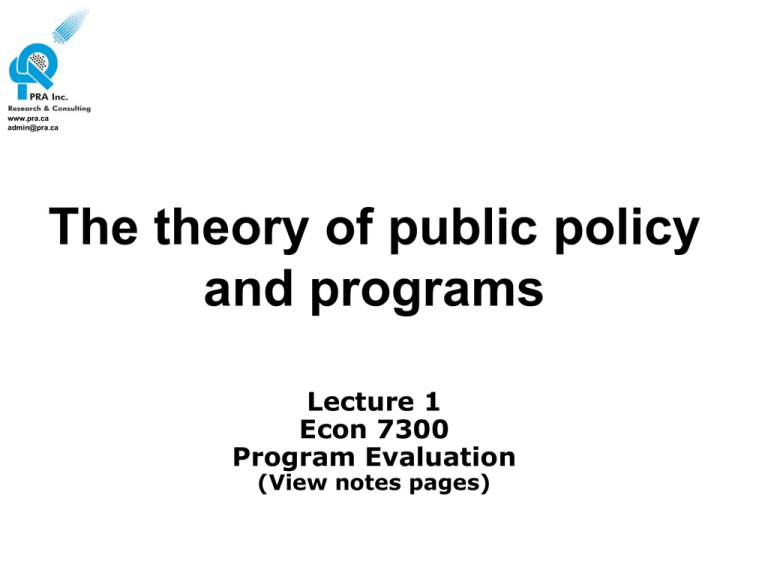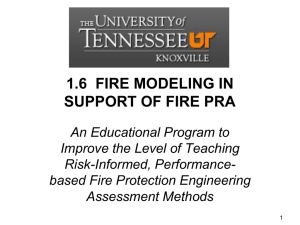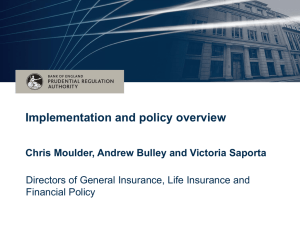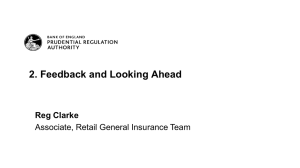
www.pra.ca
admin@pra.ca
The theory of public policy
and programs
Lecture 1
Econ 7300
Program Evaluation
(View notes pages)
www.pra.ca
admin@pra.ca
Page 17
Greg Mason, 2001
www.pra.ca
admin@pra.ca
Foundations of Policy
Development
• Public policy rests responding to deviations from some
norm.
• Norms derive from social, religious, cultural, ethical or
economic principles.
• The decision to change a “natural outcome” rests on a
comparison of the intervention costs compared to the
intervention benefits.
• Economists use the norm of a “competitive economy” – the
prices (including wages, interest, profit, etc.) that would
ensure in a hypothetical world of perfect competition.
• The economic model leads to a robust structure for
modelling policy.
• In the last year the theory of macro-economic policy has
come under substantial criticism.
• Micro-economics, however, remains largely intact.
The economics of bliss
www.pra.ca
admin@pra.ca
Neo-classical economics makes a series
of assumptions about human behaviour:
– We are rational and make choices that
maximize our welfare
– Information is costless and complete
– Our behaviour as consumers and producers
does not affect the welfare of other
producers and consumers
The Norm of Perfect Competition
www.pra.ca
admin@pra.ca
If:
• Each buyer and seller is small – no monopoly (single seller) or
monopsony (single buyer).
• A market has Many buyers and sellers.
• Perfect information exists (all buyers and sellers have the same,
full knowledge of market opportunities and any change is known
by all instantaneously).
• The costs of becoming a buyer or seller are negligible.
Then:
• Prices will reflect only the cost of production and no “extra” profit
will be earned.
• No seller will earn more or less than any other seller.
The economic rationale for intervention to adjust
the distribution of benefits (goods and services)
that would exist in a competitive equilibrium.
Changes in social surplus
www.pra.ca
admin@pra.ca
• Consumer surplus is the difference between
the personal assessment of value and price.
• Producer surplus is difference between the
price and the willingness to sell price.
• Social surplus is the sum of consumer and
producer surplus.
Implications of perfect competition
1. Prices reflect the full cost of production.
2. No profit is earned, no rent is earned.
3. Prices adjust instantaneously to any shock.
www.pra.ca
admin@pra.ca
Small problem – perfect
competition never exists
But then neither do perfect children, perfect spouses, etc.
That does not prevent us from imaging an ideal against
which to compare the existing state, and under some
conditions to effect a policy change
This seems like an ideal world, except:
•no incentive to innovate, explore or do anything new.
•technical and social change do not occur.
Imperfection impels change
www.pra.ca
admin@pra.ca
Main deviations from
perfect competition
• Public goods – goods and services where the
value cannot be entirely appropriated by the
seller/producer
– Pure public good – production means that
anyone can share without having to pay (radio
broadcasts)
– Mixed public good – production involves
benefits/harms that are exist, but the
purchaser still retains much of the benefit, the
producer does not bear all of the costs..
• Market failure – private costs/benefits diverge
from public costs/benefits.
www.pra.ca
admin@pra.ca
Two important deviaitons from
perfect competition
• Monopoly/monopsony (single seller or buyer)
– Sellers use trademarks, predatory pricing and coercive tactics to
extract extra income from consumers/taxpayers.
– Natural monopoly conferred by technical features that allow the
incumbent supplier to enjoy falling costs (increased profits)
arising from expansion, thereby preventing entrants.
• Externalities (pollution)
– Consumers and producers (more often) create by-products that
affect the welfare of those who are not direct parties to
transactions.
– This means that the cost to the consumer (private cost) does not
include all costs since some are borne by those who may not
consume the product directly.
Why does government exist?
www.pra.ca
admin@pra.ca
Three main rationales for public sector action:
– Market failure (consumer ignorance of mortgages, pollution)
– Externalities (public goods and bads)
– Distributional unfairness (poverty)
1. Market failure typically evokes a regulatory response (e.g.,
consumer education, fair lending laws, securities regulation).
2. Public goods encourage government to supplement private
sector provision of a good or services (e.g., subsidization of crop
insurance, subsidization of vaccines, public education).
3. Distributional fairness can result in regulatory, direct provision
of a service, or direct cash transfer
– Laws regarding usury, anti-discrimination legislation
– Public housing
– National child benefit, progressive tax,
lower income households
GST rebate for
Government provided goods and services
Pure Public
Goods
Defence, public health, external trade,
education, transportation infrastructure
www.pra.ca
admin@pra.ca
Public
Goods
Market Failure
Risk
management
Subsidies to basic research, northern
geo-science mapping
Information
failures
Moral hazard, asymmetric information,
time myopia..
External effects
Pollution control, subsidies to education,
compulsory vaccination...
Decreasing Cost
Regulation (price, profits, revenues..),
nationalization
Market
Manipulation
Prosecution, fines, incarceration ...
Monopoly
Merit
Goods
www.pra.ca
admin@pra.ca
Definition of government
initiatives
• Social marketing to promote a goal (articulation of goal or
intent; guidance on preferred behaviour)
• Expenditures on goods and services
Direct resource commitments on goods (public housing,
vaccination)
Direct resource commitments on services (consumer
information, training)
Tax expenditures (tax deductions and credits awarded to
citizens and businesses to behave, spend, invest, etc.)
Grants/contributions/contracts to third parties to perform
services
• Legislation is a general framework for how citizens conduct
themselves (smoking bans, criminal code) and requires political
assent.
• Regulation modifies elements of legislation (changes to the
speed limit) and can be completed by administrative fiat.
Information Failure
• Moral hazard
– Market participants alter their behaviour in response to
the divergence of public and private costs
– Taxes/subsidies cause market participants to
purchase/sell less/more than would have occurred with
prices equal to the marginal cost
• Asymmetry of information
– Sellers are typically more informed than buyers
– Prisoners paradox - information lack produces suboptimal outcomes
• Uncertainty about other players reactions causes poor
decisions
– Nash equilibrium exists when I account for your
probable reaction to my choices. Equilibrium exists
when we have all adjusted and readjusted to each
others choices/decisions.
www.pra.ca
admin@pra.ca
Government provided goods and services
www.pra.ca
admin@pra.ca
Public
Goods
Merit
Goods
Quality of Life
Support for arts ,recreational sports, community
centres, ethno cultural support...
Nationalism
Support for elite arts and sports,...
Redistribution
Progressive income tax, National
Child Benefit, GST rebate...
Safety Net
Social assistance, employment
insurance, farm safety nets,
workers’ compensation...
Equity, Fairness
www.pra.ca
admin@pra.ca
Distributive justice as a merit
good
• Equity/fairness
• Pareto efficient outcomes are not
often (never?) “fair” Recent
research shows that ideas of
equality and fair distribution
become settled for most people
One can judge a society by how it takes care of its
by the
age of 10*. Strong
weakest.
evidence exists that humans
develop altruistic instincts early.
Daniel Moynihan (US Senate)
www.pra.ca
admin@pra.ca
Value for money
Value for money can be defined as:
www.pra.ca
admin@pra.ca
• Relevance – Are we doing the right thing?
– Program addresses a demonstrable need, is appropriate
to the federal government, and is responsive to
Canadians
• Performance – Are we achieving value?
– Economy: Are taxpayer resources well-utilized?
– Efficiency: Are program outputs (services and
products) achieved in an affordable manner?
– Effectiveness: To what extent have program objectives
been achieved? That is, what results were produced? Are
the costs of achieving program outcomes minimized?
Adapted from Treasury Board Secretariat of Canada
http://www.tbs-sct.gc.ca/eval/ppt/dec06-001/vfmppor_e.asp
Relevance
www.pra.ca
admin@pra.ca
Relevance (need) emerges in two ways:
– Consumers validate the demand for goods and
services in the market place (private goods).
– Government determines needs that the public
sector may legitimately provide (government
provision of private and public goods).
• Private and public goods
– Private goods allow all the benefits/costs to be
consumed (internalized) by the consumer.
– Public goods have external benefits and costs
that cannot be internalized (i.e., externalities
Measuring the value for money
www.pra.ca
admin@pra.ca
Two requirements:
• Measure the “bang”
• Measure the “bucks”
Benefit cost = “bang per
buck”
Cost - benefit = “buck per
bang”
Cost-effectiveness analysis – What is
the cost of specific outcomes arising
from different interventions that produce
that outcome?
www.pra.ca
admin@pra.ca
Foundations of public sector
decision-making
www.pra.ca
admin@pra.ca
CBA, CEA, and CUA compared
www.pra.ca
admin@pra.ca
CBA
Monetary value of net change to welfare
of all outcomes for all stakeholders ($)
Social cost ($) (tangible and intangible)
CEA
Outcomes (outputs, inputs)
(actual changes measured in natural units, not $)
Cost of outcome ($)
CUA
Value of outcomes
(subjective value of outcomes - adjusted natural units, not $)
Cost of outcome ($)
CBA, CEA, and CUA compared
www.pra.ca
admin@pra.ca
CBA
CEA
CUA
Scope
Global –
multiple
outcomes
valued
Local –
single
output/outc
ome
Local –
single
output/outc
ome
Unit of
measure
for
outcome
Money
equivalent
Natural
Utility or
perceived
value of
outcome
Time
frame
Primary
Extended
Immediate/ Immediate/
short-term short-term
Prospective Retrospecti Retrospecti
CEA and the results chain
www.pra.ca
admin@pra.ca
Where CEA is
usually done
Activities
Outputs
Where CEA is
ought to be done
Immediate
outcomes
Longer-term
outcomes
(Typically within a year)
(Up to 15 years)
Economy
Efficiency
Effectiveness
Cost to complete activities
(E.g., Staff time per client
assessed)
Cost per client trained
(E.g., Total training costs
divided by graduates)
Cost per client that becomes employed
(E.g., Total program costs divided by
number that maintain employment for
specified time)
CEA links directly to performance monitoring
CEA
www.pra.ca
admin@pra.ca
Outputs and outcomes must be
strategic
(and valid and reliable)
• Outputs and outcomes should reflect
the core goals of the program.
– An output/outcome selected for CEA should be
selected to reflect the activity of a program.
For this reason, outputs often replace
outcomes in cost-effectiveness analysis
because they are easier to measure.
• Outputs and outcomes must be
strategic.
– A single output/outcome, if used alone, must
represent a central goal of the program.
Cost concepts
www.pra.ca
admin@pra.ca
• Opportunity cost – the cost of what is
given up
– The opportunity cost of taking this workshop
is the loss of the next best alternative.
– The opportunity cost of going to school is
the income that could not be earned. If
someone is unemployed, the opportunity
cost of hiring them is the value of the leisure
they give up.
– The opportunity cost of building an overpass
is other projects that cannot be completed.
• Direct costs – the costs of goods and
services
• Indirect cost – the time spent by
www.pra.ca
admin@pra.ca
www.pra.ca
admin@pra.ca
Budgets are inadequate for cost
analysis
• Budgets typically do not include all the
costs associated with a project.
Example: Most departmental program
budgets exclude the cost of
overheads, such as rent and utilities.
Senior management costs may not be
included.
• Public accounting for capital costs may
allocate the entire cost to one year, or
may not include these costs at all.
• A program budget may be a small
www.pra.ca
admin@pra.ca
Components approach to
costing
Steps:
• Describe each intervention in terms of
the resources needed.
• Include only those that are relevant for
the intervention to develop a marginal
cost.
• Become very familiar with each
intervention and how it operates.
Worksheet approach to components
Levin & McEwan (2001) use a worksheet
to map the costs associated with a
project.
Programs to reduce truancy
www.pra.ca
admin@pra.ca
Example – Programs to reduce
dropout rates
Progr
am
A
B
C
Dropou Cost per
Total Dropo
t
dropout
cost
uts
prevent prevent
ed
ed
$13,
18
17
$794
500
$12,
20
15
$850
750
$7,5
28
7
$1,071
00
Teac
her
opini
on
-
+++
+
Activity-Based Costing (ABC)
www.pra.ca
admin@pra.ca
• Defects in the standard costing include:
– Inability to identify costs across service lines
(programs) within a unit
– Inclusion of many costs as indirect or
overhead costs
– No assignment of large blocks of variable
(labour costs) to service lines (programs)
– Cannot support the calculation of the
marginal value of service lines.
• Activity-based costing breaks down
branch/ministry costs into costs related
Example: Process chart for
legal aid
www.pra.ca
admin@pra.ca
• One element
of legal aid in
Manitoba
offers service
on a payment
plan for low
income
residents
whose income
exceeds the
eligibility
Conventional
Financial Statement
www.pra.ca
admin@pra.ca
The time cost
(time in an
activity) multiplied
by wages is
entered for each
staff person for
each activity and
each program
.......
Salaries
Total Labour Costs by
Program
Activity-based Cost Statement
Program1
Program 2
Cost of activity 1
in Program 1
Cost of activity 1
in Program 2
Cost of activity 2
in Program 1
Cost of activity 2
in Program 2
Cost of activity 3
in Program 1
Cost of activity 3
in Program 2
+
Total time cost of
all activities in
Program 1
+
..............
+
..............
Other share for
Program 1
+
+
Total time cost of
all activities in
Program 2
+
+
+
+
+
Other
Rent share for
Program 1
+
+
+
Rent
Program k
Rent share for
Program 2
+
+
+
Other share for
Program 2
+
Cost of activity 1
in Program k
Cost of
activity 1
Cost of activity 2
in Program k
Cost of
activity 2
Cost of activity 3
in Program k
Cost of
activity 3
+
+
Total time cost
of all activities in
Program k
Total time cost
of all activities in
All Programs
+
+
Rent share for
Program k
Total Rent
+
+
Other share for
Program k
Total Other
=
=
Total Cost
Program 1
cost
=
+
Program 2
Cost
+
Program
Cost k
=
Total Cost
www.pra.ca
admin@pra.ca
CEA example –
Vaccination programs for
employees
• Outputs include the numbers
vaccinated.
• Outcomes include:
– Sick days
– Total number of employees affected
• The program with the lowest cost per
vaccination is the most cost-effective in
terms of outputs.
• The program with the lowest number of
sick days per dollar cost is the most
cost-effective in terms of outcomes.
CEA example - Training
interventions
www.pra.ca
admin@pra.ca
A common goal for many training
interventions is the return to work.
Typical examples of outcomes include:
• Return to work for six months
• Hours of work after the intervention
• Number of trainees who become
employed
• Wages after training
www.pra.ca
admin@pra.ca
CEA Example –
Early Childhood Development
• Early evaluations showed major gains in IQ and
grade advancement as a result of early
childhood interventions
• Recent evidence suggests major benefits
including:
– Higher levels of verbal, mathematical, and intellectual
achievement (1 – 2 years)
– Greater success at school, including less grade
retention and higher graduation rates (1 – 10 years)
– Higher employment and earnings (15 + years)
– Better health outcomes (1 – 10 years)
– Less welfare dependency (15 + years)
www.pra.ca
admin@pra.ca
Example – Grants and
contributions
• Increasingly used as federal approach to
policy because:
– Provincial/municipal governments have
increasing constitutional authority over public
services
– Provincial fiscal capacity limited and federal
government often called into level playing field
• The result is a policy where the federal
government taxes and transfers funding to
provinces and NGOs.
– Federal departments are increasingly removed
from the delivery point of services
– Provincial governments may “roll” federal
www.pra.ca
admin@pra.ca
Potential approaches for Gs&Cs value for money assessment
Advantages
Disadvantages
Ignore the problem
(assess only federal
component)
• Avoids delays and
nasty confrontations
• Incomplete
evaluations (impact
and delivery)
• Eliminates the
leverage effect
• Limited
accountability
(financial but not
value for money)
Move to contracts
• Assures delivery of
program base on
“verifiables”
• Payment on proved
performance
• May result in limited
capacity to deliver
programs –
adversely affects
program delivery
Cost Utility Analysis:
Using QALY and HRQL
www.pra.ca
admin@pra.ca
CUA uses self-report data (surveys, focus groups, etc.) to measure
the quality of and outcome (years of life after medical
treatments).
• Many treatments do
not restore perfect
health.
• Subjective measures
score perceived
health out of 10:
Health-related
quality of life (HRQL)
and quality of life
years (QALY).
QLAY for a patient compared to
healthy person
Year
Patient
Healthy
1
.7
1
2
.6
1
3
.5
1
4
.4
1
5
.3
1
Total
2.5
5
www.pra.ca
admin@pra.ca
From CEA to CBA
www.pra.ca
admin@pra.ca
www.pra.ca
admin@pra.ca
CBA rests on basic ideas in
welfare economics
Welfare economics
The sub-discipline of economics that analyzes changes in the wellbeing of individuals/communities arising from changes in economic
policy.
Cost-benefit analysis is the empirical measurement of changes in
well-being.
Community or social welfare is the sum of the welfare of individual
community members.
www.pra.ca
admin@pra.ca
The main features of cost-benefit
analysis
CBA - a decision-making framework to
compare the welfare of stakeholders
before and after an intervention.
• Sums the benefits and costs arising from
an initiative
• Translates any change in individual
welfare into a dollar amount; this can
include benefits such as:
Avoided harms (deaths from disease)
Lost wages due to inability to work
Steps in a CBA
www.pra.ca
admin@pra.ca
• Enumerate the stakeholders (individual,
government, society)
• Enumerate and value the “stream” of costs
and benefits
• Compare costs and benefits
www.pra.ca
admin@pra.ca
Enumerate stakeholders
www.pra.ca
admin@pra.ca
• Including all impacts in a cost-benefit
model often leads to double counting.
• Primary effect represents the first-round
impact (costs and benefits of the change)
• Secondary effect is the induced impact
Example: A new public transit system, typically reduces the travel time
arising
from
market
transactions
(primary effect),
whichlinked
in turn increases
the desirability
(price and rent)
of homes close to with
stations. the
The change
in prices and rents of homes
associated
change.
induced by changes to transit are a second round and should not be
included in the CBA. This would double count the benefits which have
already been measured by the reduction in travel time.
www.pra.ca
admin@pra.ca
Valuation of benefits and
costs
Advantages in using money values of
benefits and costs
– All costs and benefits may be included in
the calculation
– A single project/initiative can be
analyzed alone; projects where benefits
exceed costs pass the CBA test.
– Sometimes primary outcomes cannot be
measured, but secondary outcomes may
be measureable.
However, many are uncomfortable
Time value of money
www.pra.ca
admin@pra.ca
(Discounting)
The future value F of an amount P ($100), saved
for k years
at an interest rate i of 10% is
F $100(1 i)k $100*(1.1)3 $100*1.33 $133
(assuming interest is paid on the last day of each year and
the savings are deposited on the first day)
With prevailing interest rates of 10%, someone
should be indifferent between receiving $100
now or $133 in 3 years.
The present value P of receiving $133 in three
years (assuming interest at 10%) is $100.
The stream of future income
Present Values
www.pra.ca
admin@pra.ca
0%
5%
10%
Future Values
www.pra.ca
admin@pra.ca
HPV Vaccination of School Age Girls (Grade 6)
HPV – Key facts
www.pra.ca
admin@pra.ca
• HPV is a common virus with over 100
strains.
• It is responsible for a range of conditions,
most importantly the cause of cervical
cancer as well as a range of other
conditions in women and men.
• The incidence of cervical and other cancers
caused by HPV is low: compared to the
other major cancers experienced by
women, i.e., lung, breast, and colorectal.
• Women typically experience cervical
cancer in their forties, fifties, and sixties.
www.pra.ca
admin@pra.ca
www.pra.ca
admin@pra.ca
Selected readings
www.pra.ca
admin@pra.ca
Boardman, A.E., Greenberg, D.H., Vining, A.R., &
Weimer, D.L. (2006). Cost benefit Analysis:
concepts and practice. Upper Saddleback River,
N.J.: Pearson/Prentice Hall. (A standard
reference)
Just, R.E., Hueth, D.L. & Schmitz, A., (2004). The
Welfare Economics of Public Policy. Cheltenham,
UK: Edward Elgar. (An advanced graduate text)
Levin, H.M. & McEwan, P.J. (2001). Costeffectiveness. Thousand Oaks, CA: Sage
Publications. (An accessible introduction)
Treasury Board of Canada. (1998). Benefit Cost
Analysis Guide. Retrieved April 7, 2003 from
www.pra.ca
admin@pra.ca
Estimating the value of
intangibles
• Intangibles include life, peace and
enjoyment, pollution (consumption)
• Value of life – direct measure
– The typical method is to estimate the present
value of the stream of future earnings
– Basis for compensation awards
• Indirect measure (hedonic)
– Useful for assessing social costs
– The discounted value of land is a common
reference process for external effects such as
The benefit cost structure
www.pra.ca
admin@pra.ca
• The core benefit cost model
BC Ratio k 0 Bk / (1 i) / k 0 Ck / (1 i)
n
k
n
k
Net Benefits k 0 ( Bk Ck ) / (1 i)k
n
Net benefits (B1 C1 ) / (1 i) (B2 C2 ) / (1 i)2 .. (Bk Ck ) / (1 i)k
Limits/challenges of CBA
www.pra.ca
admin@pra.ca
• Defining the scope is always a
problem. A narrow scope (just
program recipients) ignores others
such as those not eligible, whose
exclusion may be a dis-benefit
(cost).
• Double counting is hard to avoid
since taxes/subsidies always find
their way into the costs/prices of
private assets.
Example 1 – Traffic congestion
www.pra.ca
admin@pra.ca
Overpass: A new suburban
subdivision is created beyond a main
east/west transcontinental rail line.
With 2,000 new households, new
retail malls, and a main road linking
north and south, traffic delays caused
by rail traffic are substantial.
Option 1: Create an overpass at a
cost of $30 million
Example 2 – Vaccination
programs
www.pra.ca
admin@pra.ca
Benefit
• Reduced short-term cost due to illness
• Reduced long-term cost for caring for
the small number of catastrophic
incidents
• Averted loss of incomes for those who
are disabled/dying
• Averted costs of lost time at work and
play
Cost
www.pra.ca
admin@pra.ca
Summary: CEA, CUA, and CBA
decision tools
• CBA/CEA provide information to
assist a decision, but the ratios are
not the decision.
• CUA can inject some subjective
elements into a CEA, but it depends
on credible (reliable and valid)
valuation processes.
• CBA/CEA reflects the values of the
analysts; it cannot discover new
Breakout sessions
www.pra.ca
admin@pra.ca
• Reversing peanut bans in
schools
• Deregulation of taxicabs in
The
breakout session seeks to create the analytical framework
Edmonton
for a cost-effectiveness or cost-benefit analysis.
•TheDelisting
selected health
key questions include:
• Who are the stakeholders?
•services
What costs and benefits fall on the stakeholders?
• What are the primary and secondary issues?
• What consideration (political, ethical, legal, etc.) might
dominate and pre-empt a cost-effectiveness or costbenefit analysis?
www.pra.ca
admin@pra.ca
Measuring outcomes
(Gross and net impact)
Measuring outcomes: The bang
www.pra.ca
admin@pra.ca
Three key concepts for measuring net
impact (the bang):
• Counterfactuals form the philosophical
base
• Gross versus net impacts – net impact is
the required measure
• Techniques to measure net impact
–Randomized trials (clinical, lab, field,
and large social experiments)
www.pra.ca
admin@pra.ca
Page 39
www.pra.ca
admin@pra.ca
Causal Framework
for Policy Design
Thought
experiments
Observational
studies
Statistical
control and
natural
experiments
Quasi
Experiments
Empirical
experiments
Lab
Field
Social
experiments
The nature of random clinical trials
www.pra.ca
admin@pra.ca
• Randomization into a treatment and
control group creates two groups that are
statistically equivalent:
– For any statistic (mean, variance, etc.) the two
groups as a whole will return results that are
the same (within bounds of statistical
significance).
– The test of statistical equivalence applies to
observable and unobservable attributes.
• Manipulation of the treatment
supports inferences about:
The random clinical trial Donezepil
www.pra.ca
admin@pra.ca
Clinical Decline
Score at start
0 mg (control)
P
w lace
as b
ho o
ut
Mental
Functioning
Clinical
Improvement
5 mg
10 mg
6
12
18
24
30
Months
www.pra.ca
admin@pra.ca
Using participants and non-participants
to create program and comparison
groups
• Many programs have those that are
eligible for service, but who elect not to
participate.
– Part 2 of the EI Act specifies training programs
for which current and past EI beneficiaries
may receive support.
– Low-income families may or may not choose
to participate in social assistance.
– Some farmers choose not to participate in
crop insurance, even with the government
subsidy.
– Some parents choose to home school.
The simple comparison group
model
www.pra.ca
admin@pra.ca
T = 1 (treatment)
= 0 otherwise
B
Bhat = Ybar(T=1) – YBar (T=0)
Y
ei
Visualizing regression
www.pra.ca
admin@pra.ca
Intervention
(=1, 0 otherwise)
X2
...
Control variables
X1
B1
Y
B2
Bk
e
Xk
Y = B1X1 + B2X2 + .... BkXk + e
The error term
captures all the
omissions from
the model as
well as the
measurement
errors in all
variables
www.pra.ca
admin@pra.ca
Measuring net impacts in
universal programs
• Universal programs admit all eligible
participants.
• This means that it is not possible to
identify a treatment and comparison
group.
• Methods
– Pre-post
– Parallel group
– Limited treatment
• Any method other than a randomized trial
cannot identify net impacts; however
Summary on value for money
www.pra.ca
admin@pra.ca
A. Assuming that one can show
relevance and sound program
theory
B. Value for money has two
requirements
– Measurement of net impact attributable to
the intervention
– The cost of the intervention
www.pra.ca
admin@pra.ca
Client valuation of program
relevance
Consumer choice and relevance
www.pra.ca
admin@pra.ca
Formal CBA occurs where no market
exists. Millions of consumers perform
informal CBA every day.
The key idea is that, in the absence of
a market for the program, it is possible
to collect data that mimic market
decisions. The willingness to pay for
some public investment reflects its
value (benefit).
The willingness to pay (WTP) to reach
www.pra.ca
admin@pra.ca
Example: discrete choice methods
for estimating labour supply
• A client survey, conducted as part of
the National Child Benefit
evaluations, randomly assigned
social assistance respondents to
three groups.
• Respondents in each group agreed
or disagreed with a specific
question: “Would you accept a job at
$Y per hour?” where Y varies with
the group.
www.pra.ca
admin@pra.ca
Example: stated choice experiment
in
social policy preferences
• Focus group participants (NCB
evaluation) rated various options for
income and in-kind support.
• A stated choice experiment consists
of a trial, or a series of trials,
typically conducted as part of a focus
group, in which the researcher makes
purposeful changes to the
attributes/levels of a policy package
in order to observe and identify
www.pra.ca
admin@pra.ca
Case study of a training
program
Taking Charge! – a training program for
single parents on social assistance
www.pra.ca
admin@pra.ca
Taking Charge! was a pilot program
jointly funded by HRDC and the
Manitoba government. It focused on
offering a range of supports for single
parents on income assistance.
Key features included:
• High level of support (e.g., daycare,
counselling, basic education, volunteer
experience, job placement)
• The program recruited Income
www.pra.ca
admin@pra.ca
“Cost-benefit” model
www.pra.ca
admin@pra.ca
• This is a hybrid program, with the
analysis from the perspective of the
government.
• It is technically a CEA, but since the
benefits are avoided costs (reduced
social assistance and taxes arising
from incremental employment), the
outcomes are naturally valued in $.
• Basis for net impact comparison:
– Control group (SA clients who never
www.pra.ca
admin@pra.ca
Summary of post-intervention experience
Percent remaining on
Average time
assistance
to come off
Group
assistance
3
6
9
(months)
months months months
Treatment (Taking Charge!)
79%
71%
65%
20
Employment Connections
76%
63%
55%
14
Comparison
79%
67%
58%
16
Control
87%
82%
74%
23
www.pra.ca
admin@pra.ca
The benefit-cost framework
Costs
A. Income assistance
payments during training
+ B. Training allowances
(books, special needs)
+ C. Cost of training
= D. Total costs
Benefits
E. Increased benefit reductions
because of earned income
+ F. Reduced income assistance
due to lower time on welfare
+ G. Increased taxes from
employment earnings
= H. Total benefits
www.pra.ca
admin@pra.ca
Benefit-cost results (see previous slide for interpretation of A, B, C, D, E, F, G, H)
Costs
Benefits
Costs
Reduce
IA while in Training
Reduced
BenefitGroup
per
Total
d time Taxes Total
training
needs
in benefits
cost ratio
client
on IA
A
B
C
D
E
F
G
H
D/H
Taking Charge!
$633
$6 $3,112 $3,751
$1,360 $2,046 $205 $3,611 0.96 0.51
Comparison
$267
$55 $1,341 $1,663
$1,136 $4,550 $181 $5,867 3.53 1.54
Control
$2
$0
$2
$598
$0
$77 $675







